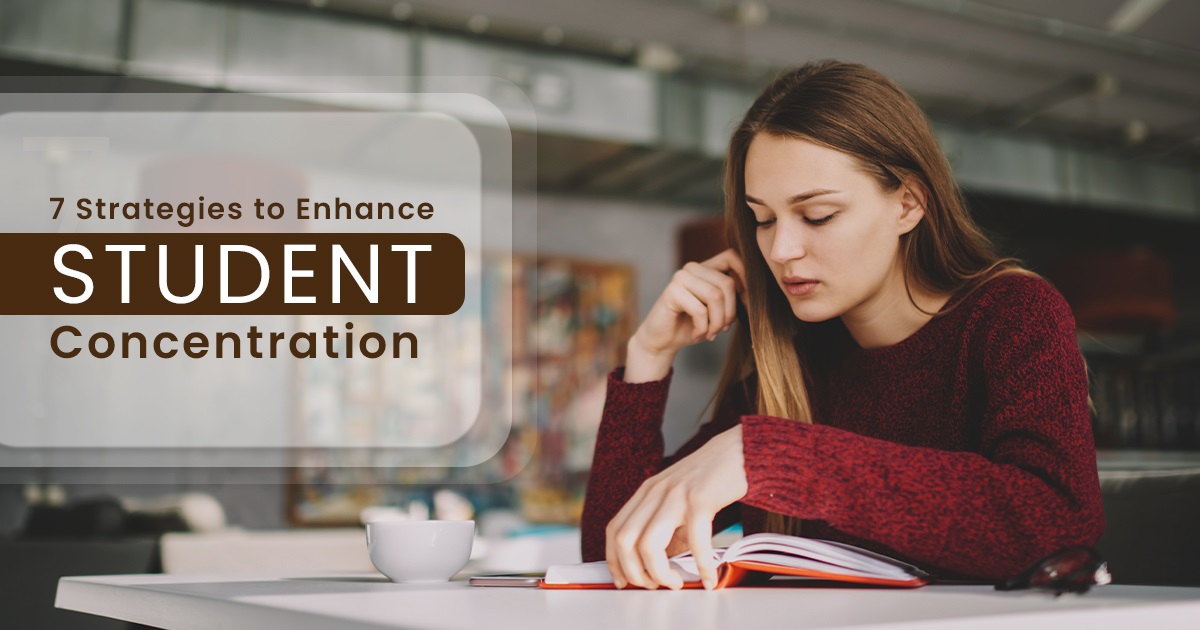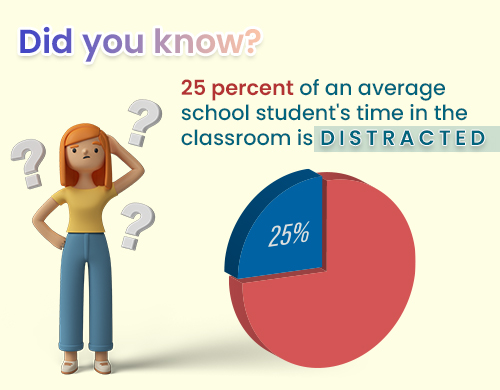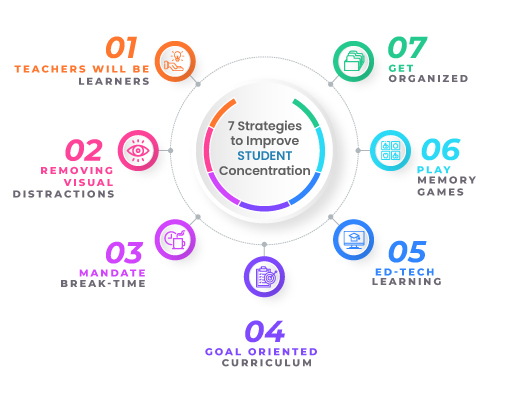
Classroom learning can now be challenging as students have become habituated to studying at home; after a prolonged period of distance learning through online modes. To help them adjust, teachers must use strategies to help students focus in the classroom learning experience.
Such strategies include reducing visual distractions, providing breaks, and creating an organized learning environment.

In one study, researchers concluded that about 25 percent of an average school student's time in the classroom is distracted—not learning.
This study showed that students needed to pay more attention and retain the material taught during class. Failure to do so can lower their grades and cause a lack of understanding of the subject.
Additionally, this can have a long-term effect on the student's future academic and career success.
Strategies to help students focus in the classroom involve several practices. It is similar to building muscle; students must practice and develop their focus over time. Working with an online tutor can help students improve their concentration and academic performance.
When we ask our brains too much without giving ourselves a quick mental break, our focus will become taxed more heavily than usual, leading to reduced performance until somebody gets their brain recharged with some active playtime breaks during the day!
Teachers ought to allow short active play breaks for students who have attention issues. A small break can involve:
Doing so can be a useful way to reduce stress levels and improve concentration.

By providing teachers with the same learning opportunities that students receive, they can better understand how to create an environment conducive to concentration.
Educational institutions must perform routine training for teachers, including participating in online and in-person workshops, developing effective teaching techniques, and implementing digital tools.
By doing so, teachers can stay up-to-date on the latest educational trends and technologies, discover more effective ways to engage students, and be better prepared to use digital tools in their classrooms.
These workshops will help ensure students receive the most appropriate education.
Benefit:
Teachers can learn about the latest technological tools, teaching strategies, and instructional methods by attending workshops and seminars. This will help them create a more stimulating learning environment for their students.
They can also gain valuable insight into the current trends in education, which will help them create lesson plans and activities that are more effective and engaging.
For example, a seminar on virtual reality in the classroom could show teachers how to use VR to create immersive learning experiences that can effectively engage even the most reluctant learners.
Through virtual reality, teachers can construct engaging environments that capture students' attention and lead to meaningful learning experiences. VR can help students understand abstract concepts and problem-solving techniques faster, as the immersive environment allows for a more intuitive understanding of the content.
Additionally, learning through virtual reality will help to keep students focused and motivated throughout the learning process.
Removing Visual Distractions from Classrooms can create an environment that is less cluttered and more conducive to learning. It can include removing motivating wall art, fancy hanging objects, etc.
The presence of too many objects in the environment can be overwhelming and can lead to overstimulation. Removing these objects can help reduce distractions and make the environment more conducive to learning.
Benefit:
Reducing visual clutter should be a priority for instructors to provide their students with the maximum chance of success. The average human concentration span is 8.25 seconds, ranging from 2 seconds to over 20 minutes.
Teachers and institutions should work together to provide students with minimalistic slides in the classroom so they can concentrate and absorb the material. Additionally, instructors should strive to break up the lecture with visuals, activities, and other interactive elements.
Be mindful of your students' downtime if you want them to achieve strong learning results. The more a student can relax during their break time, the better their learning results will be all day long!
Providing students with the opportunity for a break, either through physical activities or simply allowing them to relax, helps them to stay focused and recharge their batteries.
For instance, many schools have implemented outdoor recess during the school day to allow the students to move and blow off some steam, which can help them refocus during class.
Break-time can lead to improved concentration, behavior, and academic performance.
Benefit:
Providing students with regular breaks is among the most practiced strategies to help students focus in the classroom. It enhances their concentration power, allowing them to relax, recharge, and concentrate on their learning tasks more efficiently.
By designing lessons that align with a student's interests and goals, teachers can cultivate greater engagement and focus in the classroom.
For example, a student interested in engineering may find concentrating on a bridge physics lesson easier than on the Renaissance's history.
Tailoring lessons to student's interests and goals helps them engage and allows them to learn more deeply and better understand the topics. Students passionate about the lesson are likelier to retain and apply the information to their lives.
Benefit:
For instance, with a Goal Oriented Curriculum, students can set specific learning goals and track their progress throughout their educational experience.
It's like having a roadmap to reach a destination - you have the final destination in mind, then break down the steps needed to reach it, and students can monitor their progress along the way.
Tasks and goals can boost students' motivation. Undoubtedly, lesson plans leave a significant mark on students' focus, encouraging them to be aware of their goals and keep track of their accomplishments.
The ability of the revised curriculum to help students concentrate on tasks that carry out those plants' objectives is another benefit.
Ed-tech and online learning can provide a more interactive and engaging learning environment to help improve student concentration.
It can also provide students with more opportunities to apply the knowledge they have learned. Moreover, it allows students to work independently and review the material multiple times if needed.
According to a study by Science Direct, around 70% of teachers use technology in the classroom to a moderate or large extent.
Integrating technology into the classroom allows students to become more actively involved in learning. It also encourages critical thinking, problem-solving, and teamwork, as students can engage with the material in a more interactive way.
Benefit:
For example, using an interactive whiteboard can help teachers keep their student's attention by providing interactive animations with rich content and helping break up the uniformity of lecture-style teaching.
Playing memory games is essential to building a more focused mindset for a child. Such activities can help to improve a child's concentration, boost their confidence, and enhance their overall cognitive functioning.
Benefit:
For example, students can play a classic game of concentration with any standard deck of cards, where the child has to remember the card they flipped over and match it with another card of the same value.
Mixing up the cards allows the game to be played repeatedly, giving the child more opportunities to exercise their memory and strategic thinking.
The child can even play against a timer to add a challenge, increasing the game's difficulty. The game can also be adapted for two or more players, making it a great way to encourage teamwork and friendly competition.
Also Read: Top 4 Benefits Of Game-Based Learning For Learners In 2023
For the most efficient learning experience, learning how to organize classwork is essential.
You can avoid things piling up and getting out of hand by becoming familiar with various institutional hacks for the classroom now. Additionally, implementing these organizational strategies will help students succeed in school and their subsequent college studies.
A survey found that 75% of American high schoolers and half of the middle schoolers described themselves as "often or always feeling stressed" by schoolwork.
Stress could be attributed to the increasing academic pressure that students are experiencing and the lack of resources and support from their teachers and families. Implementing organizational strategies like creating a study plan, setting daily goals, and taking frequent breaks could help students better cope with their studies' demands.
By creating a study plan, students can
More than students, teachers and the educational institution are responsible for implementing strategies to help students focus in the classroom. Parents should also be involved in encouraging students to focus on their studies.
Furthermore, technology can be employed as a tool to help students stay engaged and focused. Finally, creating an environment conducive to learning is also important in helping students stay on task.
Share